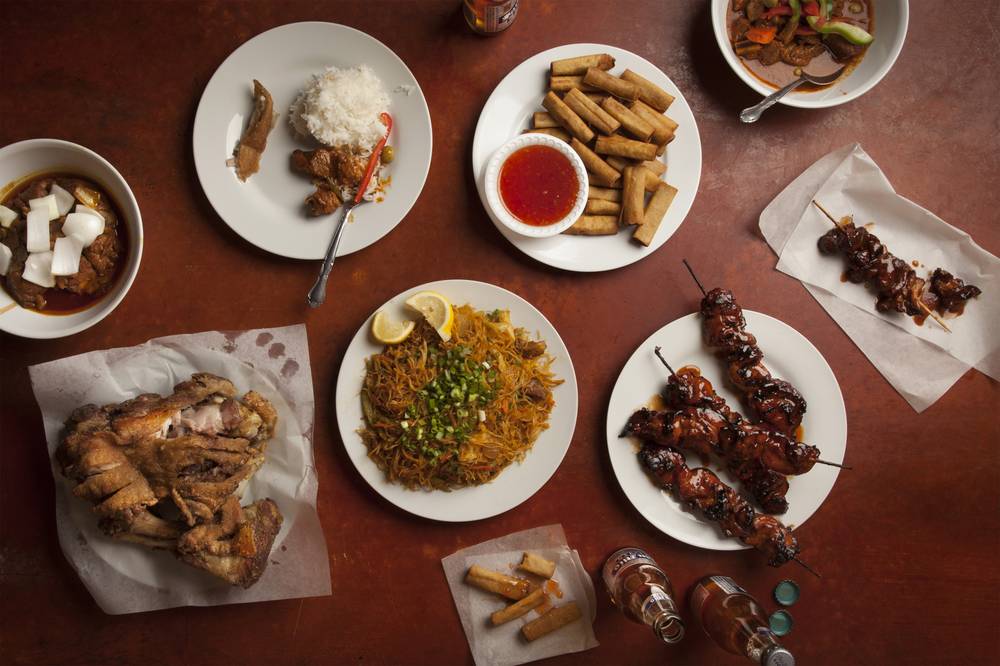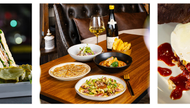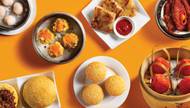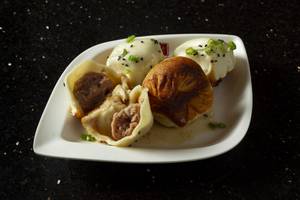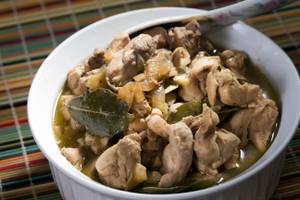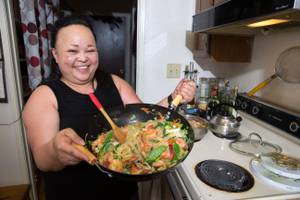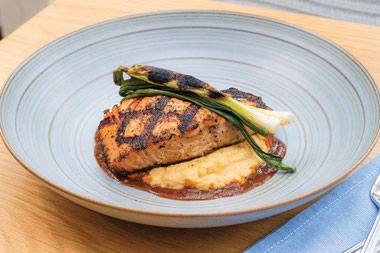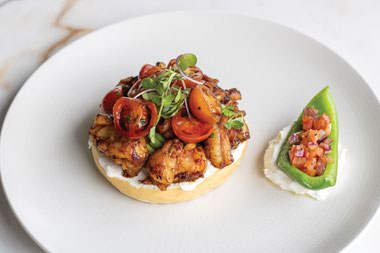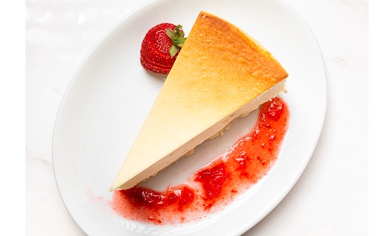Matakaw. “That’s Tagalog for one who eats a lot,” my friend Karin says playfully, referring to me, or maybe both of us. My stomach rumbles as I Google the word on my phone. The best translation match? Gluttonous. Gobbler. Gourmand. They’re all great descriptors. If there’s one person up for eating her way through the city with me it’s Karin, and our friendship has always been inextricably tied to food. On this particular evening, her mom, Arlene, is cooking for us, a gathering that emerged from a simple question: Where should we go for Filipino food in Vegas? “Honestly, I haven’t eaten a lot of it,” Karin confesses. The cuisine is traditionally meat-heavy, and since her family went vegetarian years ago, Filipino food became less common in her household. But tonight, mother and daughter are going all-out, and I’m the lucky guest.
October is Filipino American History Month, but living in a city as diverse as Las Vegas, we should celebrate communities of color all year round. In 2010, Nevada became home to the fastest-growing Filipino population in the U.S., and two years later, Filipinos became the largest Asian group in Nevada. One might assume, then, Filipino food would be as heralded here as other Asian cuisines—Thai, Japanese, Chinese … Yet it remains largely underexposed in Las Vegas, despite its strong presence.
“I’m from Texas, and we don’t have any Filipino restaurants out there,” says Joy Lavado, shift manager at Fiesta Filipina restaurant in Henderson. “When I first moved here, I was like, Oh, my God, there’s a lot of Filipino restaurants out here.” Indeed, from Fiesta Filipina to Tina’s Filipino Cuisine, Joy’s Restaurant to Goldilocks Bakeshop & Restaurant, there are quality Filipino restaurants in every part of town, spots that deserve attention. So why haven’t they gotten much?
In May, NBC Asian America launched a video series called Voices. In one segment, titled “Lunch Box Moment,” Asian Americans delved into the social and political context of food—specifically how they were teased by their peers for eating culturally specific foods in school. “My hunger for my family’s food was overpowered by my desire to fit in, so I minimized Chinese food’s role in my life and learned to make pasta instead,” author Ruth Tam echoes in a Washington Post article. “Little did I know that Americans would come to embrace the dishes and cooking styles that once mortified me … In some cases, this shift has been heartening. But in too many others, the trend has reduced staples of our culture to fleeting fetishes.”
As I delved into the cuisine of the Philippines, it was necessary to address the culture behind it. After all, food without context is food without its community.
In Psychology Today, University of Alaska Anchorage associate professor E.J.R. David notes that Filipino slaves on Spanish ships landed in modern-day California in the 16th century, becoming the first documented Asians to settle in the United States. The Philippines is the only Asian country to have been colonized by the U.S., and the Philippine-American War at the turn of the 20th century “seems to be unacknowledged, hidden and forgotten.” It goes far beyond food.
Like music and art, cuisine can be a connective force that reveals deep traditions and bonds within communities. “It makes you not homesick, or it reminds you of being home,” Lavado says of her ties to Filipino food. “I haven’t been back there in a long time. I was born there, and now I have two kids here. It’s something that I can introduce to my kids. They were born here. When they grow up, even if they don’t go to the Philippines, it’s something they can [remember]—I’ve had Filipino food, I’m Filipino.”
Inside Fiesta Filipina, I order a smorgasbord: lumpia, pancit, crispy pata and more. The pancit, a popular rice noodle dish, is light but full of vegetables and chunks of pork, and the pata, deep-fried pork hock, is like carnitas on steroids, with skin so rich and delicious it’s almost sinful. The lumpia, the Filipino version of eggrolls, are explosively crunchy and savory. For dessert, it’s halo-halo, a multi-textured dish made from a variety of sweets—colorful ice creams, jellies and fruits—and leche flan, similar to Mexican flan, but creamier.
Karin’s parents were born in the Philippines, but when her great grandfather, Pablo Quindo, was recruited by the military to clean up Guam after World War II, he was granted citizenship. “He ended up living [in Guam] and bringing his whole family there,” Arlene says. “That’s how we all ended up in Guam.” More than 250,000 Filipino-Americans are veterans of World War II.
Arlene tells me the story of her grandfather while sautéing chicken for adobo, a Filipino standby made with garlic, vinegar and soy sauce. It smells heavenly. “We were raised by my grandparents,” Arlene says, the meat sizzling in the pan. On another burner, she adds shrimp, vegetables and noodles to a wok for pancit. “They [taught us] you do things for yourself … by [age] 9, [we had] to know how to cook rice. You’re not Filipino if you don’t have rice.”
When the pancit is finished, Karin and I slice up eggs as garnish and set the table. The noodle dish is “almost like making a turkey [in the States],” Arlene says. “You have to know how to do it.”
We dip lumpia in banana sauce, a tomato ketchup flavored with fruit. I ask Arlene what she misses most about life in the Philippines and Guam. “Every weekend it would be a party at the beach,” she says, then revisits my question a few moments later. “You know what I also miss the most? Family.”
After dinner, Karin’s mom brews a pot of tea and suggests we make paper cranes, a tradition in their artistic household. Karin and her mom cut the orange tea-bag wrappers into small squares and Karin guides me through the process. A bowl overflowing with a colorful mound of paper birds sits in a glass cabinet. “Keeping your hands busy keeps your mind busy,” Arlene explains. She’s right. For more than an hour we sit, chatting and folding delicate paper into different shapes.
Before I know it, it’s 10:30 p.m. Arlene packs up two containers of food, the cranes sitting gracefully on top as a keepsake from our evening.
Talking for hours over adobo and learning about my friend’s family brought us closer than any of our fancy restaurant outings ever could. Obviously, a delicious dinner isn’t the only path to understanding a culture, but I’m certain about this: The foods we eat and the reasons we eat them have a significance that extends far beyond the table.
Five Filipino spots to try right now
Tina’s Filipino Cuisine Tina’s offers just about everything you could request, from sinigang (a sour, tamarind-based soup) to lechon kawali (deep-fried pork belly) to fried bangus (milkfish) with a side of vinegar for dipping. Don’t miss the melon juice or ginger tea, either. 7720 S. Jones Blvd., 702-998-5880.
Cafe De Cebu Order the kare-kare (savory oxtail stew made with peanut butter), bangus sisig (a rich, vinegary dish made here with fish, calamansi juice, peppers and onions), or dinuguan, a pork stew cooked in pig’s blood and spices. Leave room for the turon with ube ice cream. Masarap! (That’s tagalog for delicious.) 3399 S. Jones Blvd., 702-538-7588.
Fiesta Filipina With three locations, satisfying your crispy pata fix is super convenient at this family-owned stop. Must-tries include barbecue pork and chicken skewers, beef caldereta (short-rib stew in tomato sauce) and halo-halo for dessert. 2980 St. Rose Parkway #120, 702-476-1122; 3310 S. Jones Blvd., 702-252-0664; 8565 W. Warm Springs Road, 702-776-7733.
Joy's Restaurant This homey Filipino buffet offers a little bit of everything for just $6.99 (but be forewarned, it’s cash only). Stock up on the usuals: crispy pata, BBQ sticks, lumpia, pancit and arroz caldo, a porridge cooked with chicken, ginger and spices. 1430 E. Charleston Blvd., 702-764-6952.
Goldilocks Bakeshop & Restaurant This chain has some of the best pastries and cakes in town. Craving an ube-filled ensaymada (sweet bread topped with grated cheese) or hopia (flaky, sweet pastry)? This is your place. Snag some traditional dinner rolls—pandesal—on your way out. (Note: It’s temporarily closed for remodeling.) 2797 S. Maryland Parkway, 702-368-2253.
